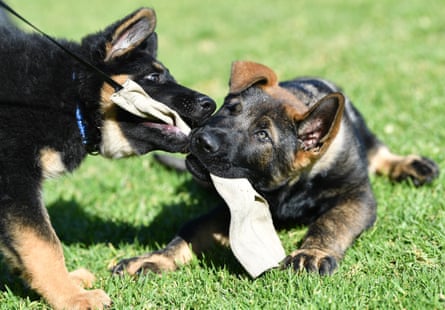PROTECT YOUR DNA WITH QUANTUM TECHNOLOGY
Orgo-Life the new way to the future Advertising by AdpathwayAmerican staffordshires (Amstaffs) registered in NSW had the highest rate of attacking a child, adult or other dog in 2024, statistics show.
But experts warn the data may not show the full picture, because dog breeds can be wrongly identified – sometimes deliberately – and often not identified at all.
In over a fifth (1,305 of 5,901) of dog attacks on humans and animals recorded in NSW last year and compiled by the Office of Local Government (OLG), no breed was specified.
There were 941 attacks by Amstaffs, with 5,023 of the breed registered, meaning an attack for about every one in five dogs, but if Amstaff crossbreeds are included, there were 6,784 registered and 1,028 attacks – one attack for every 6.6 dogs.
By comparison, there were 146 attacks by Australian kelpies, with 5,903 registered in NSW, meaning an attack for every 40 dogs. Kelpies were the second-most popular crossbreed in NSW in 2024, behind miniature dachshunds (6,484 registered, 11 attacks, about one for every 600 dogs).
More than 270 of the people attacked in 2024 required hospital care.
Amstaffs – a purebreed – share a common pit bull ancestry with staffordshire bull terriers (staffies), but are bigger.
Sign up: AU Breaking News email
Pit bulls are barred from importation to Australia and face restrictions under state laws, which could act as an incentive to register pit bulls or pit bull crosses under other breed categories.
There were 2,740 staffies registered and 360 attacks attributed to them – an attack for every 7.6 dogs.
Other dogs responsible for higher numbers of attacks include German shepherds, rottweilers and bull mastiffs.
The NSW government is reviewing its companion animal laws in the wake of fatal dog attacks.
In January the NSW deputy state coroner Carmel Forbes handed down her findings into the death of a five-week-old baby (known as “MJ”), who was mauled to death by the family dog – a six-year-old Amstaff called Bully.
Four weeks before killing MJ, Bully had attacked and killed a neighbour’s cocker spaniel.
Forbes recommended the government review the Companion Animals Act, look at introducing licence conditions for particular breeds of dogs, and for dog owners to be licensed.
“Many fatal attacks have involved American staffordshire terriers (or crossbreeds thereof), staffordshire bull terriers (or crossbreeds thereof) and rottweilers,” she said, adding that there were “substantial difficulties” differentiating between Amstaffs, pit bulls and staffies.
Forbes says she suspects some dogs registered as Amstaffs were really pit bulls or pit bull crosses.
Earlier this month, a teenager died after being mauled by a friend’s dog, which was reportedly a boxer, bull Arab and Irish wolfhound mix.
The dog attack incidents in 2024 include 2,824 attacks on adults, 461 on children and 2,598 on other dogs. A total of 430 dogs had to be euthanised.
An Australian Institute of Health and Welfare study released last year found in 2012-13, 15.9 people per 100,000 needed hospital care after a dog attack. By 2021-22, that had more than doubled to 36.9.
The latest survey by Animals Medicines Australia, released on 18 September, found almost half of Australian households (49.3%) now have at least one dog, a jump from 2013 when it was 39%.
Animal behaviourist Melissa Starling said while the “bully breeds”, which include staffies, Amstaffs, bull mastiffs and others, are overrepresented in dog attack statistics, they can often ignore factors such as individual dog temperament, owner behaviour and whether the dog is desexed.

“A lot of the staffies and Amstaffs I meet are lovely dogs, particularly towards people,” she said.
“[But] people are breeding them indiscriminately.
“The anxiety of the breed has gone off the charts … nowadays many are so stressy. They are prone to getting really aroused, and that’s where things start to unravel.”
The Australian Veterinary Association said in its submission to the NSW review that many incidents of dog aggression “stem from lack of owner awareness or poor management” and it recommends education and awareness programs. It does not support breed-specific legislation.
“Scientific evidence and experience show that any dog can be dangerous given the wrong circumstances, and aggression is more reliably predicted by owner behaviour, training history and early life experiences than breed alone,” it said.
It is calling for councils to have the power to take “early, proportionate action for dogs that show signs of aggression” such as mandatory training, containment, or muzzling orders, with strict penalties for serious or repeated attacks, clearer processes for behavioural assessments, and euthanasia as a “last resort” for “truly dangerous dogs”.
The RSPCA is against breed-specific legislation because it is “based on assumptions that certain breeds of dog are inherently dangerous, that those breeds can be readily identified, and that banning those breeds decreases the rate of dog bites and attacks”.
“All of these assumptions are flawed and are not supported by evidence,” it said in its position statement.
“Each individual dog should be assessed based on their actual behaviour.”
Forbes said in her findings that there were “powerful considerations in favour of a person being required to be licensed to own a dog”.
“I am of the opinion that the continuing instances of serious and fatal attacks by dogs in NSW justifies consideration by the minister and the OLG considering a licensing requirement for dog ownership,” she wrote.
“Requiring a person to obtain a specific category of licence to own or have certain breeds such as American staffordshire terriers, staffordshire bull terriers, rottweilers, or crossbreeds thereof (or imposing conditions that prohibit a person under a general licence from owning or having dogs suspected of being one of these breeds or crossbreeds thereof).”
Starling says people must learn to be careful, and take into account “the capacity of the dog to do harm in the first place”.
“They’re strong, they’re powerful,” she said of bully breeds in general.
“When I’m out with my 5kg dog, I know what a dog like that could do. So if I see one loose, I don’t take any chances.”


 2 days ago
5
2 days ago
5





















 English (US) ·
English (US) ·  French (CA) ·
French (CA) ·